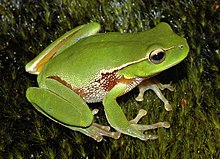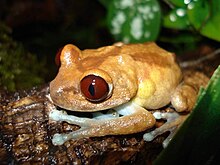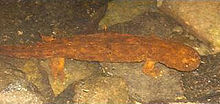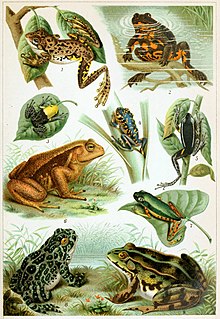The Amphibian Portal
Amphibians are ectothermic, anamniotic, four-limbed vertebrate animals that constitute the class Amphibia. In its broadest sense, it is a paraphyletic group encompassing all tetrapods excluding the amniotes (tetrapods with an amniotic membrane, such as modern reptiles, birds and mammals). All extant (living) amphibians belong to the monophyletic subclass Lissamphibia, with three living orders: Anura (frogs and toads), Urodela (salamanders), and Gymnophiona (caecilians). Evolved to be mostly semiaquatic, amphibians have adapted to inhabit a wide variety of habitats, with most species living in freshwater, wetland or terrestrial ecosystems (such as riparian woodland, fossorial and even arboreal habitats). Their life cycle typically starts out as aquatic larvae with gills known as tadpoles, but some species have developed behavioural adaptations to bypass this.
Young amphibians generally undergo metamorphosis from an aquatic larval form with gills to an air-breathing adult form with lungs. Amphibians use their skin as a secondary respiratory interface and some small terrestrial salamanders and frogs lack lungs and rely entirely on their skin. They are superficially similar to reptiles like lizards, but unlike reptiles and other amniotes, require access to water bodies to breed. With their complex reproductive needs and permeable skins, amphibians are often ecological indicators to habitat conditions; in recent decades there has been a dramatic decline in amphibian populations for many species around the globe.
The earliest amphibians evolved in the Devonian period from tetrapodomorph sarcopterygians (lobe-finned fish with articulated limb-like fins) that evolved primitive lungs, which were helpful in adapting to dry land. They diversified and became ecologically dominant during the Carboniferous and Permian periods, but were later displaced in terrestrial environments by early reptiles and basal synapsids (predecessors of mammals). The origin of modern lissamphibians, which first appeared during the Early Triassic, around 250 million years ago, has long been contentious. The most popular hypothesis is that they likely originated from temnospondyls, the most diverse group of prehistoric amphibians, during the Permian period. Another hypothesis is that they emerged from lepospondys. A fourth group of lissamphibians, the Albanerpetontidae, became extinct around 2 million years ago. (Full article...)
Selected frog article
Selected salamander article
The Cryptobranchoidea are a suborder of salamanders found in Asia, European Russia, and the United States. They are known as primitive salamanders, in contrast to Salamandroidea, the advanced salamanders. It has two living subdivisions, Cryptobranchidae (Asian giant salamanders and hellbenders), and Hynobiidae, commonly known as Asian salamanders.
Giant salamanders are obligate paedomorphs with partial metamorphosis, but Asiatic salamander goes through a full metamorphosis. The only known exceptions are the Longdong stream salamander, which has been documented as facultatively neotenic, and the Ezo salamander, where a now assumed extinct population from Lake Kuttarush in Hokkaido had neotenic traits like gills in adults.
The oldest members of the group are known from the Middle Jurassic (Bathonian) aged Yanliao Biota of China. (Full article...)List of selected salamander articles
|
|---|
Did you know? –

- ...that the Cheat Mountain salamander of West Virginia is the only vertebrate known to be unique to that state?
- ... that the Permian amphibian Trimerorhachis either brooded young in its mouth or ate them?
- ... that the Cumberland Dusky Salamander is believed to hybridize with the Ocoee Salamander?
- ... that female European cave salamanders do not normally eat while they guard their eggs for six months or more?
- ... that in hot weather, the eastern spadefoot toad (pictured) may aestivate in the deep burrow it has dug?
Selected amphibian type
A frog is any member of a diverse and largely carnivorous group of short-bodied, tailless amphibians composing the order Anura (coming from the Ancient Greek ἀνούρα, literally 'without tail'). The oldest fossil "proto-frog" Triadobatrachus is known from the Early Triassic of Madagascar (250 million years ago), but molecular clock dating suggests their split from other amphibians may extend further back to the Permian, 265 million years ago. Frogs are widely distributed, ranging from the tropics to subarctic regions, but the greatest concentration of species diversity is in tropical rainforest. Frogs account for around 88% of extant amphibian species. They are also one of the five most diverse vertebrate orders. Warty frog species tend to be called toads, but the distinction between frogs and toads is informal, not from taxonomy or evolutionary history.
An adult frog has a stout body, protruding eyes, anteriorly-attached tongue, limbs folded underneath, and no tail (the tail of tailed frogs is an extension of the male cloaca). Frogs have glandular skin, with secretions ranging from distasteful to toxic. Their skin varies in colour from well-camouflaged dappled brown, grey and green to vivid patterns of bright red or yellow and black to show toxicity and ward off predators. Adult frogs live in fresh water and on dry land; some species are adapted for living underground or in trees.
Frogs typically lay their eggs in the water. The eggs hatch into aquatic larvae called tadpoles that have tails and internal gills. They have highly specialized rasping mouth parts suitable for herbivorous, omnivorous or planktivorous diets. The life cycle is completed when they metamorphose into adults. A few species deposit eggs on land or bypass the tadpole stage. Adult frogs generally have a carnivorous diet consisting of small invertebrates, but omnivorous species exist and a few feed on plant matter. Frog skin has a rich microbiome which is important to their health. Frogs are extremely efficient at converting what they eat into body mass. They are an important food source for predators and part of the food web dynamics of many of the world's ecosystems. The skin is semi-permeable, making them susceptible to dehydration, so they either live in moist places or have special adaptations to deal with dry habitats. Frogs produce a wide range of vocalizations, particularly in their breeding season, and exhibit many different kinds of complex behaviors to attract mates, to fend off predators and to generally survive. (Full article...)List of selected amphibian type articles
|
|---|
Selected images
Selected toad article

Selected caecilian article
Luetkenotyphlus is a genus of caecilians in the family Siphonopidae.
Species recognized (as of October 2019):
- Luetkenotyphlus brasiliensis (Lütken, 1851)
- Luetkenotyphlus fredi Maciel, Castro, Sturaro, Silva, Ferreira, Santos, Risse-Quaioto, Barboza, Oliveira, Sampaio, and Schneider, 2019
- Luetkenotyphlus insulanus (Ihering, 1911)
Need help?
Do you have a question about Amphibians that you can't find the answer to?
Consider asking it at the Wikipedia reference desk.
Topics
Subcategories
Related portals
Associated Wikimedia
The following Wikimedia Foundation sister projects provide more on this subject:
-
Commons
Free media repository -
Wikibooks
Free textbooks and manuals -
Wikidata
Free knowledge base -
Wikinews
Free-content news -
Wikiquote
Collection of quotations -
Wikisource
Free-content library -
Wikiversity
Free learning tools -
Wiktionary
Dictionary and thesaurus
© MMXXIII Rich X Search. We shall prevail. All rights reserved. Rich X Search










































